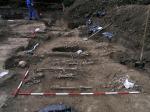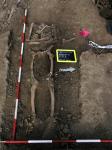Summary (English)
In July 2006, the Vinkovci Municipal Museum conducted an archaeological inspection at the Jakovci site near the village of Karadžićeva, following an oral instruction from the Conservation Department in Osijek. The position is located 1200 m east of the village on an elongated elevation that is laid north-south. The course of a dried-up Križevci stream (as the village of Karadžićevo was called until 1949) passes in the immediate vicinity. In the minefield, a trench of about 100 m2 was opened and graves found inside the trench were excavated. The trench was opened by the members of The Directorate for Detained and Missing Persons in the Ministry of the Family, Veterans’ Affairs and Intergenerational Solidarity, with the assumption that it was a mass grave from the Croatian War of Independence. After it was determined that these were much older remains, archaeologists were invited.
In this position, from the 15th to the 17th century, the village of Jakovci, together with its parish cemetery with burials in rows, was located. The last burial at the cemetery took place at the end of the 17th century. It is assumed that the settlement existed before (Bijelo Brdo culture), but this assumption can only be confirmed by archaeological excavations. The village of Jakovci or Jakabfalwa was first mentioned in historical sources in 1491. Before the Ottoman period, the last mention of the village was in 1520. In the time of the Ottomans, in the censuses written from 1550 to 1570, they are mentioned as Jakobovci. In the census from 1702 it is written that the village is abandoned (Engel; Petković 2006: 81-85). During the archaeological excavation conducted in 2006, it was determined that the burials at the cemetery were arranged in rows, with correct west-east orientation. Burials were determined at a depth of 0.30 m (this height is the result of ploughing) and can be traced to a depth of 1 m. A total of 13 graves were excavated, and by the time archaeologists arrived, they were already cleaned. There were no grave goods in the graves, only fragments of late medieval pottery have been found in the soil. The skeletons were labelled and photographed, and afterwards stored in bags and deposited at the Vinkovci Municipal Museum for further analysis (Anita Rapan Papeša 2007, Hrvatski arheološki godišnjak 3/2006, 44–45).
- Anita Rapan Papeša - Gradski muzej Vinkovci
Director
- Anita Rapan Papeša - Gradski muzej Vinkovci
Team
Research Body
- Gradski muzej Vinkovci






![Download [PDF]](/excavation/skins/fasti/images/results/download_sml.png)
